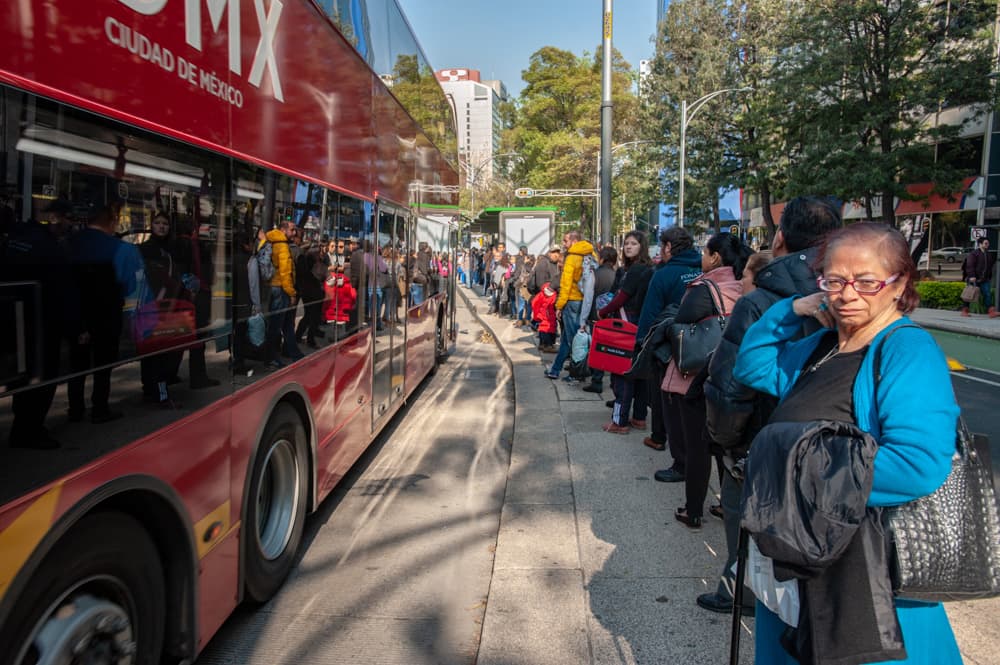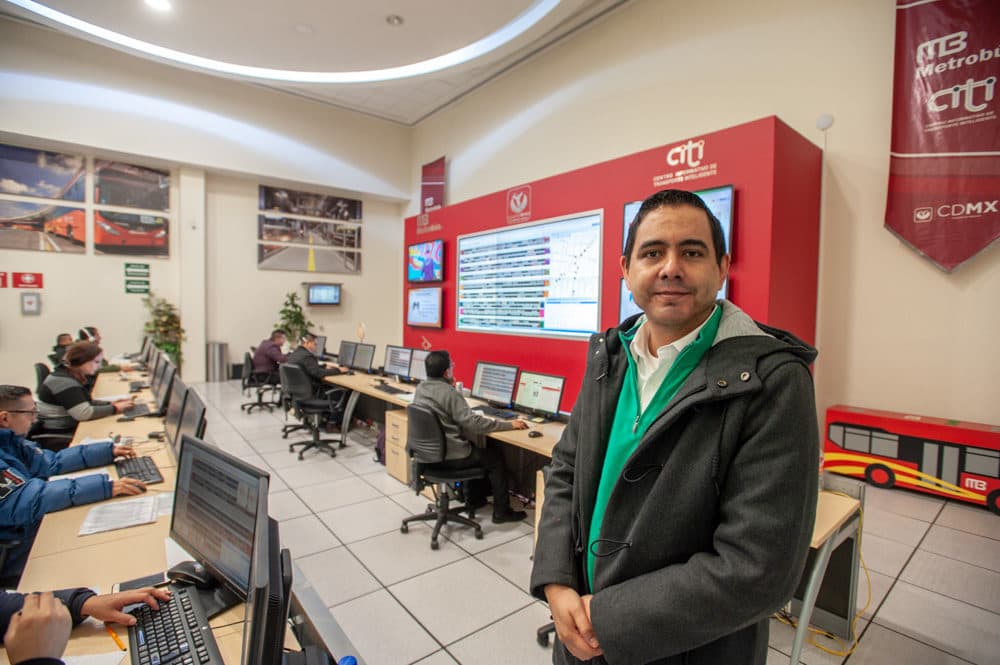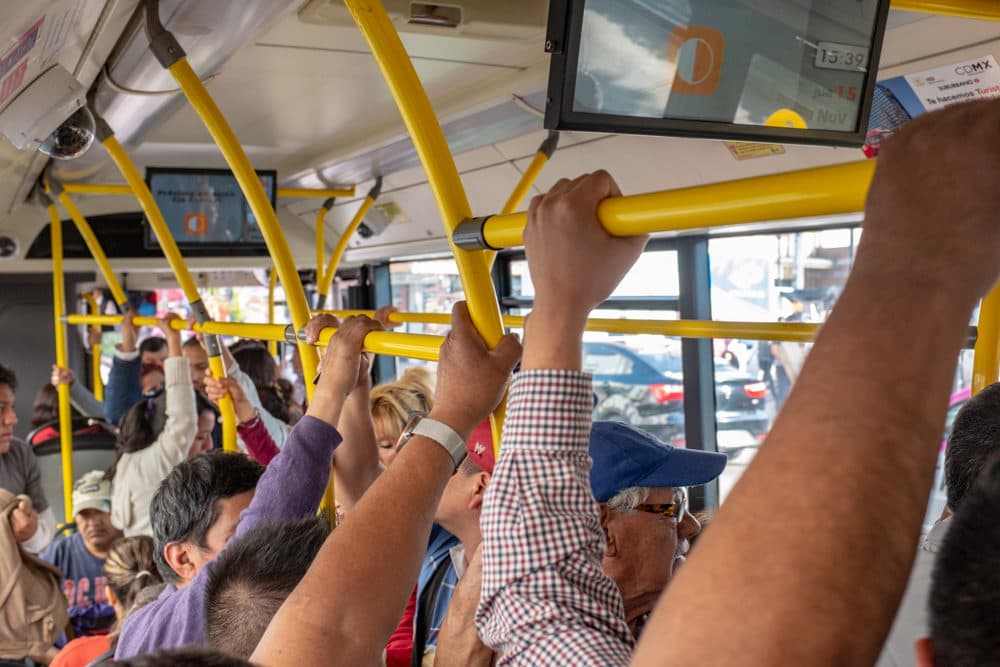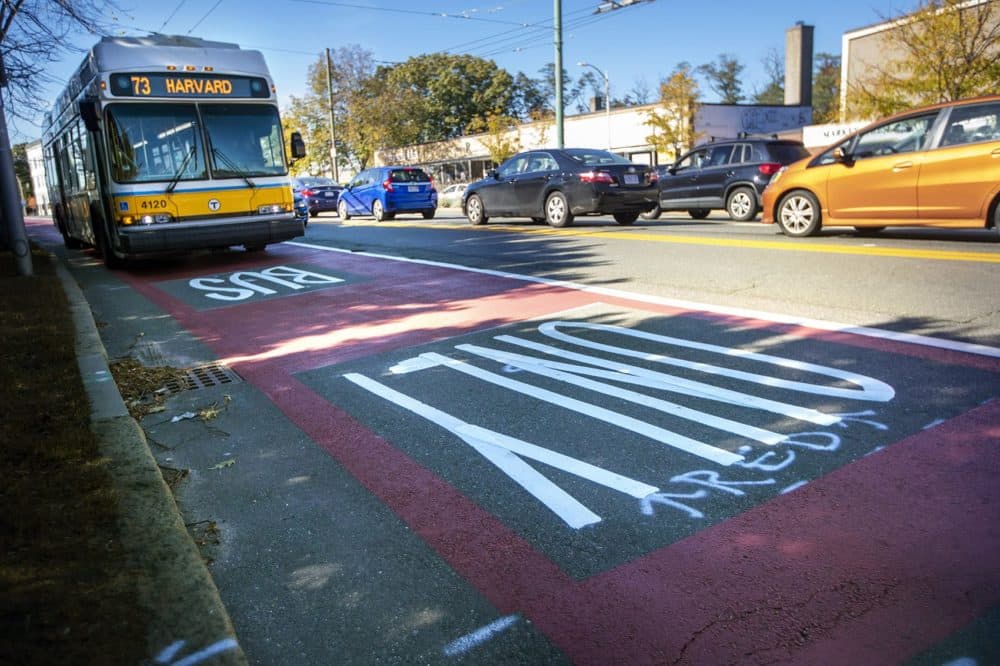Advertisement
¡Viva Buses!
What Boston Can Learn From Mexico City's Bus Rapid Transit System
Resume
Part 2 of a series. Here are Parts 1, 3 and 4.
Este reporte tambien está disponible en español.
The next big thing in transportation might be the old city bus — re-imagined.
Bus rapid transit is an innovative system that has improved commutes in cities around the world. Boston is testing it out. Mexico City already has what many experts consider one of the best systems in the world. And it may offer lessons for how to make bus rapid transit work.
Mexico City's system works a bit like a subway. You pay at a bus station instead of on board, so when the bus comes, all the doors open, and everyone gets on quickly. The system is called Metrobús. It’s fast, efficient and very popular.
"It's like a restaurant. A good restaurant is overcrowded," says Diego de la Torre, who manages Metrobús' control center, called Centro Informativo de Transporte Inteligente.
De la Torre's team monitors the entire system, using video, GPS and even social media to track hundreds of buses and keep them running smoothly.
"All the buses that could work are working in the system," de la Torre says. "So in the stations, [we] try to send one every two minutes, every three minutes."

This is what it takes to keep Metrobús riders on the move — a million and a half of them every day. And the riders breeze past car traffic on Mexico City's notoriously congested roadways because the buses have their own separate lanes.
Mexico City's mobility secretary, Andrés Lajous, says the city took away space for cars to make way for bus rapid transit — or BRT. The city also cleared out the ubiquitous private, unregulated minibuses known as "peseros" along the BRT routes.
"In Mexico City it was very fast the impact of reducing car space," Lajous says. "People at first, they reacted negatively. But once you started measuring the effects of the first BRT line, we saw that particularly people making shorter trips would dump their car pretty fast."
It took just a couple of months, Lajous says, for those drivers to make the switch.
"And that was good for them in terms of cost, and good for the city in terms of pollution and congestion," he adds.
But now Metrobús is just about maxed out. More people use it than officials expected when they started the system more than a decade ago. And riders who live outside the central part of the city travel far — and spend more money — just to get to a Metrobús line.

Riders like Vianney Najera, who works as an administrative assistant downtown.
"What happens is that in order to get to the Metrobús, obviously I have to take a pesero," Najera says in Spanish. "I think it's like an hour in a pesero and 35 minutes in the Metrobús."
Mexico City leaders have plans to build more Metrobús lines and extend some existing lines to connect with other transit options, like the subway. City officials believe this will allow the system to better handle the intense demand.
Even with these challenges, Mexico City's Metrobús offers a glimpse of how other cities might improve commutes with BRT.
"As soon as I saw the Metrobús stations I was like, this just makes so much more sense than what we have in Boston," says Sophie Greenspan, a 27-year-old graphic designer from the Boston area who now lives in Mexico City. "Like there's no advantage to taking the bus with the MBTA if you're just sitting in the same traffic that all the cars are, and even slower because [the bus] is stopping all the time."
Greenspan says she experienced this a lot when she rode the 39 bus in Boston, but not with Metrobús in Mexico City. It's a Friday afternoon outside a Metrobús station on Avenida de los Insurgentes, one of the city's longest streets, and Greenspan is on her way to pick up some artwork south of the city center. She says Metrobús has shown her that buses can be a good way to get around.
"If you can make at least some of the major bus lines and the ones that get really hit by traffic like the 39 ... if you could have that be its own dedicated lane, it would be so much faster," Greenspan says.
Bus lanes have already sped up commutes in some parts of Greater Boston.
Travel time shrank by up to 7 minutes with the addition of a bus lane on Broadway Street in Everett, according to the city. Commutes similarly dropped for riders with a bus lane on Washington Street in Roslindale, according to the city of Boston. And the Mass. Ave. bus lane in Arlington shaved off up to 10 minutes from commutes, according to town officials there.
Boston transportation officials plan to add more bus lanes. There are also pilot programs underway in other areas, including Mt. Auburn Street between Watertown and Cambridge. At the launch event for that bus lane in the fall, Transportation Secretary Stephanie Pollack said she believes buses can transform transit in the region.
"Buses are like the Rodney Dangerfield of the transit system, they don’t get the respect they deserve, and projects like this are giving buses the respect they deserve," Pollack said.
But projects like this one aren't full-on bus rapid transit. They're more like BRT-light. They don't have many of the subway-like features, such as the ability to pay at stations and board through any door. Still, transit officials believe the lanes will make buses faster — like Mexico City did with Metrobús.

"It's funny I was actually down in Mexico City at Thanksgiving and spent many hours just scouting it out and checking it out. It's very cool," says Kathryne Benesh, who oversees the MBTA's operations strategy.
Benesh says the T has its own plan for buses, which includes bus lanes, but also tweaks to bus routes and traffic signals (so buses get longer green lights).
"What's great about buses, and I think the reason they're sort of having their renaissance right now, is they are fundamentally a flexible investment," Benesh says. "When we build a train ... it's very difficult to shift based on demand. And buses, because they're flexible, we can redesign the routing, we can redesign the schedules to be far more responsive to people's actual needs."
But this can't happen without greater collaboration with cities and towns. That's because the T runs the buses, but cities and towns control the streets. Officials like Benesh say it will take investments from everyone to truly transform bus transit in the region.
This segment aired on April 30, 2019.
